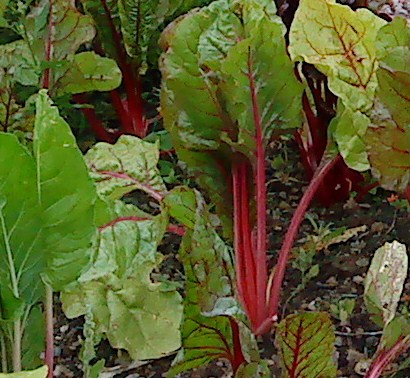
This recipe is from Leon’s Fast Vegetarian which my son very kindly bought me for my birthday last year because he thought it might give me inspiration for the weekly recipe. I will be using some of the chard from our box this week to make it.
Serves 4
Preparation time: 10 minutes
Cooking time: 20 – 30 minutes
Ingredients
150 ml white wine
2 cloves garlic, crushed
2 red chillies, deseeded and chopped
300g peas (frozen are fine)
150 ml water
100g chard, washed
salt and freshly ground black pepper
440g orecchiette
2 Tbs flat leaf parsley, chopped
extra virgin olive oil for drizzling
Method
Put the wine, garlic and chilli into a large pan and bring to the boil, then reduce the heat and simmer until the volume has reduced by half. Add the peas to the pan with the water and simmer for 2 minutes. Next add the chard and stir quickly to wilt, then remove from the heat. Remove half the pea/chard mix from the pan and blitz in a blender or food processor, then return it to the pan, stir and season well. Bring a large pan of salted water to the boil. Add the pasta and cook for about 10-12 minutes (or according to the instructions on the packet), then drain. Toss the pasta with the sauce, add the parsley and mix well. Season and serve drizzled with good olive oil.

Charlotte saw this recipe, looks nice and simple and can be made with the kale in this week’s boxes. Nigel also recommends using steamed spinach instead of the kale or a goat’s or blue cheese. Apparently the combination of spinach and blue cheese is particularly good.
Serves 2
Preparation time: 10 minutes
Cooking time: 20 mins
Ingredients
125 g of mixed greens such as cavolo nero or red Russian kale
6 eggs
salt and pepper
2 Tbs olive oil
150 g taleggio cheese, torn or sliced
3 Tbs pumpkin seeds, chopped
Method
Put a pan of water on to boil. Set the oven at 200C/gas mark 6. Wash and lightly shred 125g of mixed greens, such as kale and cavolo nero.
Add the greens to the boiling water, leave for a minute, then immediately remove and refresh in a colander under cold, running water. Gently squeeze most of the water out of the greens and set aside. Beat six eggs in a large mixing bowl, then add the shredded greens and season generously with salt and pepper.
Warm 2 tbsp of olive oil in a nonstick ovenproof 22cm pan, then, as bubbles start to appear, pour in the egg and greens mixture. Leave to cook over a moderate heat for two minutes. Tear or slice 150g of taleggio, or another soft, easily melting cheese, and place the pieces on the surface of the eggs and greens. Scatter over three tablespoons of chopped pumpkin seeds then bake in the preheated oven for 12 minutes until the eggs are lightly set and the cheese oozing.
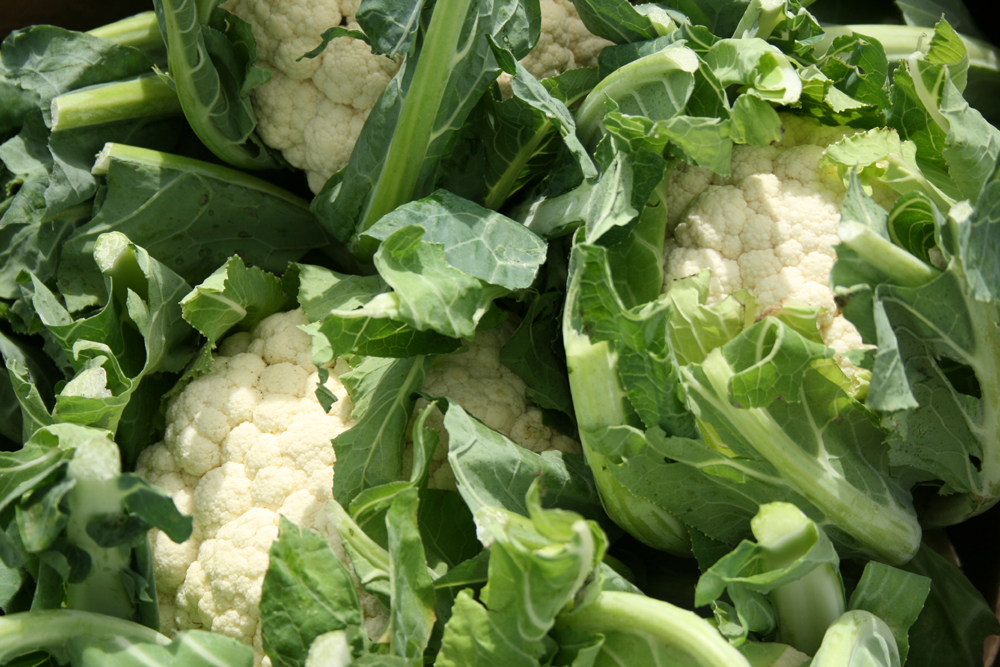
This recipe appeared in Yotam Ottolengi’s column in the Guardian recently and I have been waiting for a cauliflower to try it out. Yotam recommends: keep all the leaves on the head of cauliflower for this: when roasted, they are deliciously crisp and tasty. The addition of a few chopped anchovies would be a flavoursome addition to the butter: you won’t need the salt if you do this.
Serves: four as a starter.
Preparation and cooking time: 2- 2 1/2 hours
Ingredients
1 large cauliflower with its leaves intact
150g creme fraiche
1 tbsp lemon juice
70g unsalted butter, softened to room temperature
3 tbsp olive oil
Coarse sea salt
Method
Using a pair of scissors, lightly trim the leaves at the top of the cauliflower, so that about 5cm of the cauliflower’s head is exposed. Fill a pan large enough to fit the cauliflower in salty water. Bring to a boil and carefully lower in the cauliflower exposed head down: don’t worry if the base sticks out a little. Bring back to a boil, cook for six minutes, then transfer the cauliflower to a colander, exposed head down. Set aside for 10 minutes, to drain and cool. Heat the oven to 170C/335F/gas mark 3. Mix together the creme fraiche and lemon juice, and set aside in the fridge until required. Mix the butter with the oil. Put the cauliflower stem side down in a medium baking tray and spread the butter mix all over the white flower. Sprinkle over a teaspoon and a quarter of salt, and roast for an hour and a half to two hours, basting the cauliflower with the buttery juices five or six times during cooking. The cauliflower is done when it’s super-tender and a dark golden-brown, and the leaves are crisp and charred. Remove from the oven and serve with the lemony creme fraiche and a little extra salt for sprinkling on top alongside. Serve this in the centre of the table, for people to share with drinks at the start of a meal. Break the cauliflower apart with your hands (let it cool down a little first), dip the individual florets and crisp green leaves into the creme fraiche sauce and sprinkle with salt. For those who prefer eating with a knife and fork on separate small plates, just cut the cauli into quarters and serve individually.
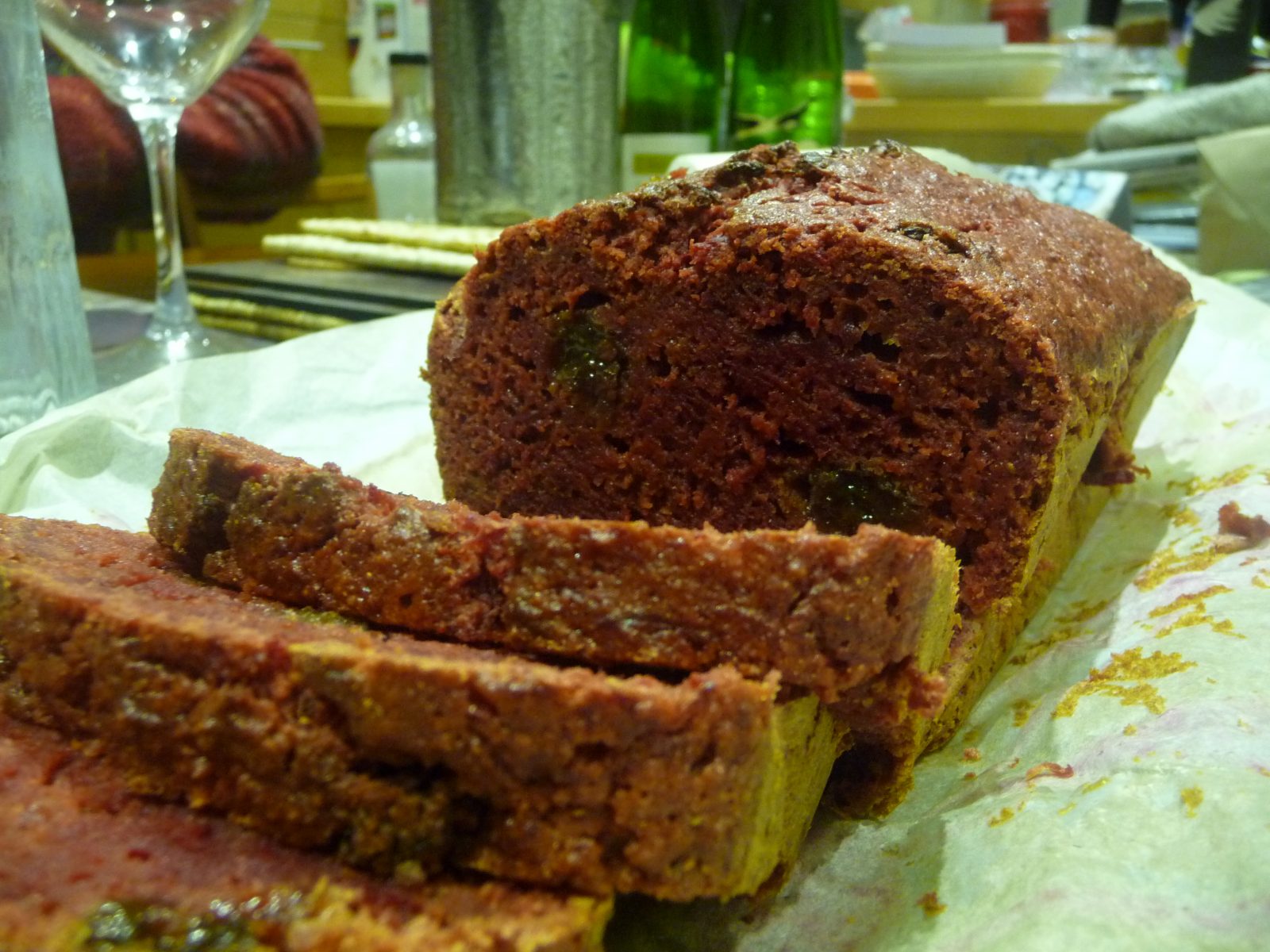
This recipe is from Hugh Fearnley-Whittingstalls book Veg every day. The original recipe was for a pumkin and raisin loaf but he suggested using beetroot instead – I’m not sure about the colour! The loaf itself is rich and sweet but also light as it doesn’t contain any butter or oil.
Preparation time: 30 mins
Cooking time: 1 hour
Ingredients
200g light muscovado sugar
4 large eggs, separated
200g finely grated beetroot
finely grated zest and juice of 1 lemon
100g raisins
100g ground almonds
200g self-raising flour
a pinch of fine sea salt
1 tsp ground cinnamon
A generous grating of nutmeg
Method
Preheat the oven to 170°C/Gas mark 3. Lightly grease a loaf tin, about 20 x 10 cm, and line with baking parchment. Using an electric whisk, beat the sugar and egg yolks together for 2-3 minutes until pale and creamy. Lightly stir in the grated beetroot, lemon zest and juice, raisins and ground almonds. Sift the flour, salt and spices together over the mixture and then fold them in, using a metal spoon. In a large clean bowl, beat the egg whites until they hold soft peaks. Stir in a heaped tablespoon of the egg white into the cake mixture to loosen it a little, then fold in the rest as lightly as you can. Tip the mixture into the prepared loaf tin and gently level the surface. Bake for about one hour, or until a skewer inserted into the centre comes out clean. Leave to cool in the tin for 10 minutes, then transfer to a wire rack to cool completely before slicing.

A neat take on a classic. This recipe from Yotam Ottolenghi in The Guardian is recommended by CSA members Charlotte Barry and Alex and Jeremy Simmons. The lentils are described as a really positive addition and cooking them from scratch will mean they are less mushy. I’m looking forward to trying it tomorrow.
Serves 4
Preparation time: 30 minutes
Cooking time: 12-14 minutes
Ingredients
50g puy lentils
1 large cauliflower, separated into 4cm florets
2 tbsp ghee
2 banana shallots, peeled and diced fine
1½ tsp cumin seeds
1 tsp curry powder
1 tsp mustard powder
2 green chillis, deseeded and finely diced
1 tsp black mustard seeds
200ml double cream
90g mature cheddar, grated
15g parmesan, grated
Salt
15g panko breadcrumbs
5g parsley, finely chopped
Method
Heat the oven to 180C/350F/gas mark 4. Tip the lentils into a small pan filled with boiling water and simmer for 18 minutes, until al dente. Drain, refresh and leave to drip-dry. Steam the cauliflower over boiling water for five minutes, until just softening, remove and set aside.
Melt the ghee in a round, 24cm ovenproof casserole pan on a medium heat, and sauté the shallots for eight minutes, until soft and golden. Add the cumin, curry and mustard powders, and chilli, and cook for five minutes, stirring occasionally.
Add the mustard seeds, cook for a minute, then stir in the cream, 80g of the cheddar, all the parmesan and half a teaspoon of salt. Simmer for a minute or two, so the sauce thickens slightly, then add the lentils and cauliflower. Stir gently, simmer for a minute more, then take off the heat.
In a small bowl, mix the panko, remaining cheddar and parsley. Sprinkle over the cauliflower, then bake for eight minutes, until bubbling and hot. Brown under a high grill for two to four minutes, until the top is golden and crisp (watch that it doesn’t burn). Remove, leave to cool down slightly and serve.
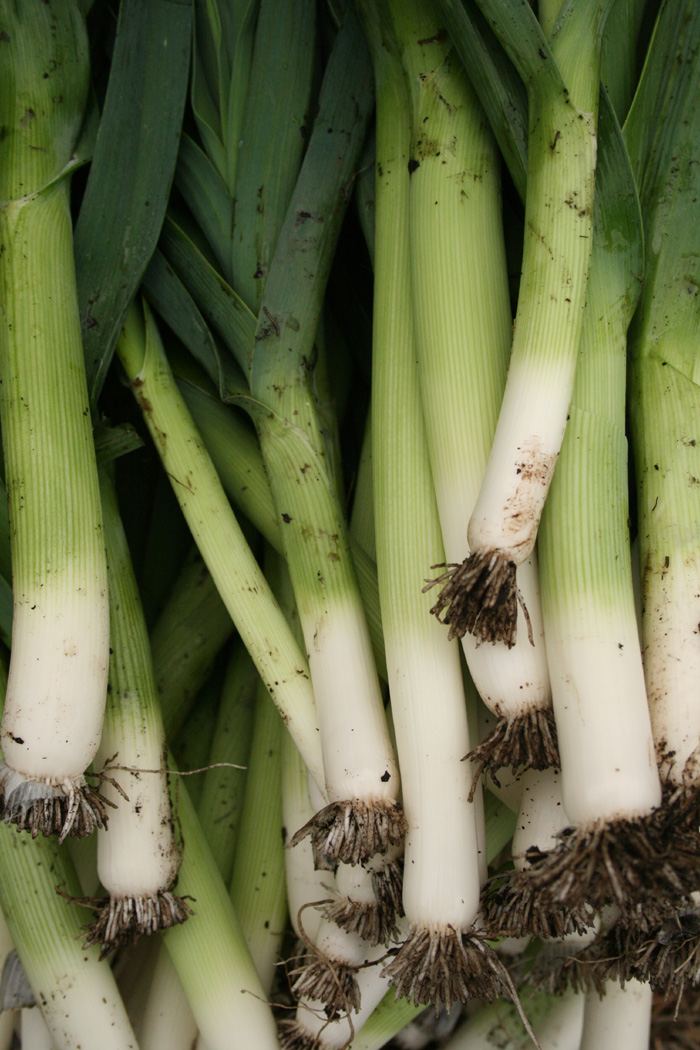
This is taken from a recipe by Rose Elliot. It was originally a recipe for a pie with a puff pastry crust but the filling is just as good on its own.
Serves 4
Preparation time: 15 minutes
Cooking time: 30-40 minutes
Ingredients
2 cans butter beans, rinsed and drained
25 g butter
225 g carrots, peeled and diced small
450 g leeks, cleaned and cut into 1 cm slices
125 g mushrooms, wiped and sliced
1 Tbs flour
1/2 can tomatoes
150 ml vegetable stock or water
salt and pepper
Method
Melt the butter in a medium-sized pan, add the carrots, cover and cook very gently without browning for about 10 minutes. Add the leeks and mushrooms and cook for a further 10 minutes. Sprinkle in the flour then stir so it gets mixed with the fat. Mix in the tomatoes and stock or water and cook gently, stirring for 2-3 minutes, until thickened. Add the butter beans and season to taste. Cook for a further 5-10 minutes until the beans are heated through. Serve with a green vegetable and potatoes.
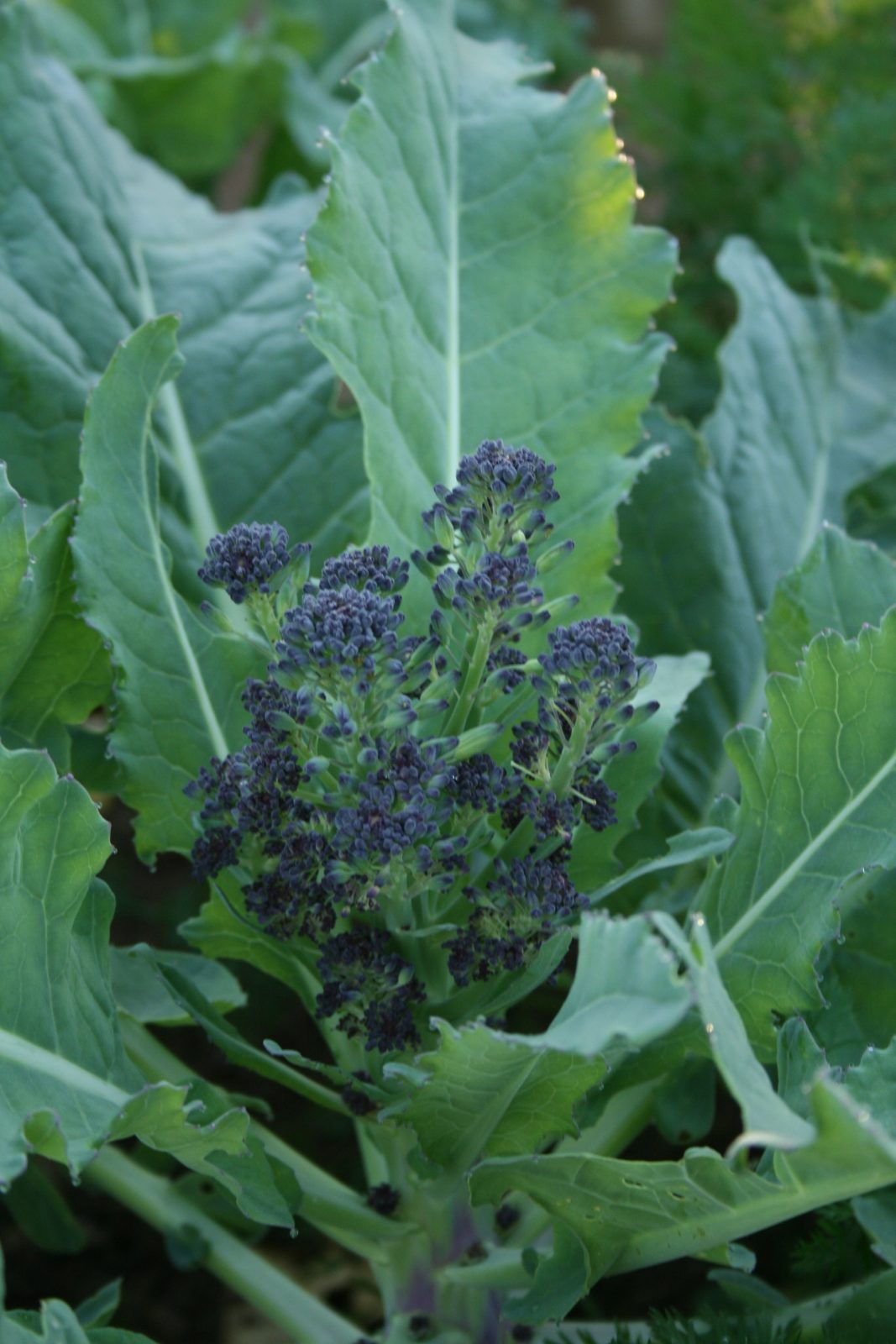
This is a variation on a recipe from Hugh Fearnley-Whittingstall’s book River Cottage Veg Every Day I posted last spring, using purple sprouting broccoli instead of spring greens, but it is so good that I think it is worth sharing it again. If you don’t have a fresh chilli you can use 2 pinches of dried chilli flakes.
Serves 4
Cooking and preparation time: 15-20 minutes
Ingredients
250g purple sprouting broccoli
6 Tbs olive oil
1 red chilli, deseeded and finely chopped
2 garlic cloves, finely slivered
300g pasta shapes such as penne or fusilli
sea salt and freshly ground black pepper
To serve:
olive oil
parmesan cheese, grated
Method
Rinse the broccoli and break into bite-sized pieces. Bring a large pan of water to the boil and add the pasta. Add the broccoli to the pasta giving it a good 5 minutes cooking time. Warm the olive with the chilli and garlic for a few minutes.
Once the pasta is al dente, drain the pasta and broccoli thoroughly and toss with the olive oil, chilli and garlic. Check the seasoning then serve with olive oil for trickling and lots of grated cheese.
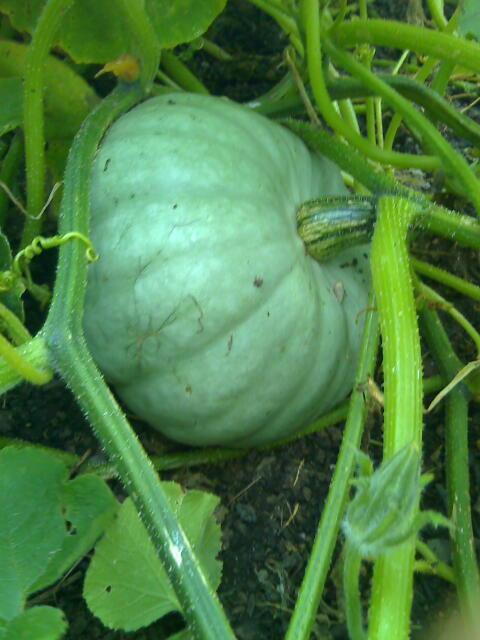
The original inspiration for this soup was in a newspaper or magazine, long since lost. This is my husband’s version where he puts in whatever squash we have together with whatever greens are around: kale, cavalo nero and chard have all been used at some point.
Serves 4
Preparation time: 20 mins
Cooking time: 30-40 minutes
Ingredients
2 Tbs olive oil
1 onion, peeled and chopped
2 cloves garlic, finely chopped
1 tsp smoked paprika
1 squash, peeled, seeds removed and diced
500 ml stock
1 can cannelini beans, drained
1 large handful of kale, torn into small pieces
Method
Heat the olive oil in a large pan, add the onion and garlic and fry gently until the onion has softened. Add the squash with the smoked paprika and coat in the oil before adding the stock and the cannelini beans. Simmer until the squash is cooked. At this point you can mash the soup slightly to make it thicker if you so wish. Add the kale and simmer until cooked. Season to taste and serve.
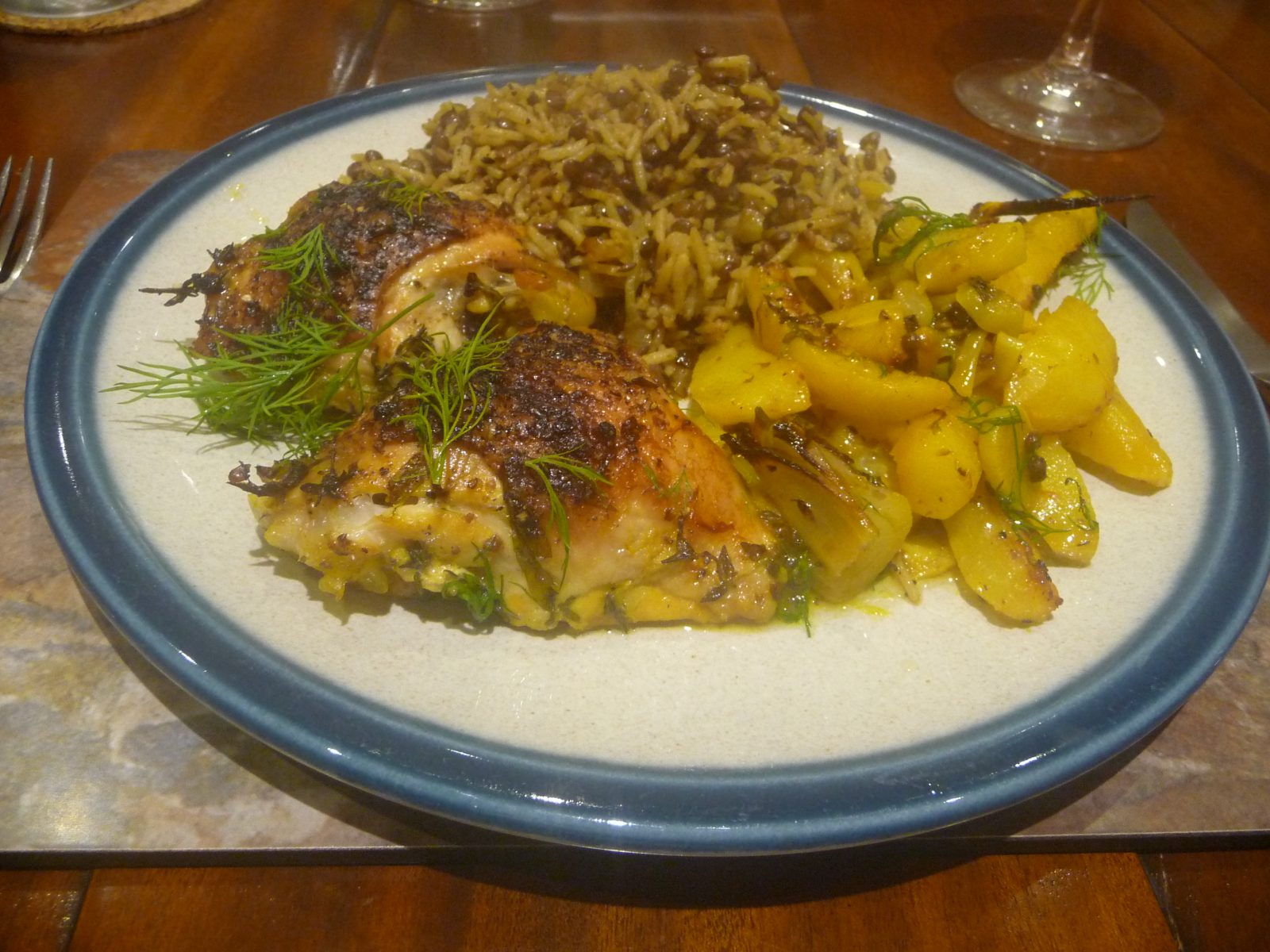
If you don’t know what to do with Jerusalem artichokes try this dish. You need to prepare it ahead of time as it requires at least 2 hours marinating in the fridge though overnight is better. It is taken from Yotam Ottolenghi’s book Jerusalem and he suggests serving it with mejadra, a rice and lentil dish, though this weekend we are going to try it with new potatoes and a green salad.
Serves 4
Preparation time: 30-40 minutes
Cooking time: 45 minutes
Ingredients
450g Jerusalem artichokes, peeled and cut into 1.5 cm wedges lengthways
3 Tbs lemon juice
8 chicken thighs
12 banana shallots, peeled and cut in half lengthways
12 large garlic cloves, sliced
1 lemon, cut in half lengthways and then thinly sliced
1 tsp saffron threads
50ml olive oil
150ml cold water
1 1/2 Tbs pink peppercorns, slightly crushed
10g fresh thyme leaves
40g tarragon leaves, chopped
2 tsp salt
1/2 tsp black pepper
Method
Put the Jerusalem artichokes in a pan, cover with plenty of water and half the lemon juice, Bring to the boil, reduce the heat and simmer for 10-20 minutes, until tender but not soft. Drain and leave to cool.
Place the Jerusalem artichokes and all the remaining ingredients, excluding the remaining lemon juice and half the tarragon in a large mixing bowl and use your hands to mix everything together well. Cover and leave to marinate in the fridge overnight, or for at least 2 hours.
Preheat the oven to 240°C/ Gas Mark 9. Arrange the chicken pieces, skin-side up in the centre of a roasting tin and spread the remaining ingredients around the chicken. Roast for 30 minutes. Cover the tin with foil and cook for a further 15 minutes. At this point the chicken should be completely cooked. Remove from the oven and add the reserved tarragon and lemon juice. Stir well, season to taste and serve.
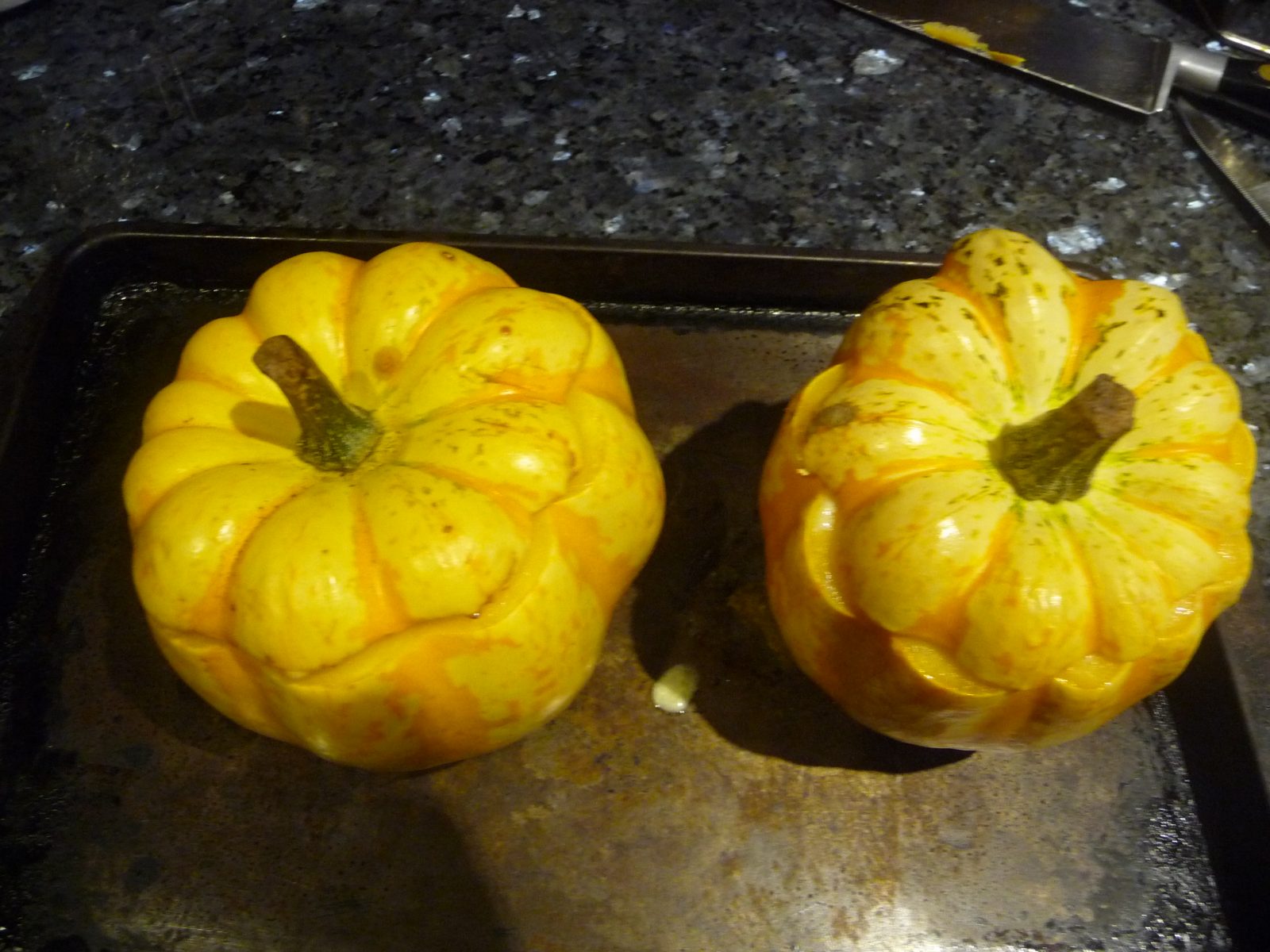
A big thank-you to CSA members Alex and Jeremy for recommending this recipe. It is taken from Hugh Fearnley-Whittingstall’s book Veg every day.
Serves 4
Preparation time: 30-40 minutes
Cooking time: 50-60 minutes
Ingredients
35g butter
2 large leeks, trimmed and thinly sliced
1 teaspoon English mustard
4 tablespoons crème fraîche
125g Gruyère or other well-flavoured hard cheese, finely grated
2–4 smallish squash (400–800g each)
A handful of thyme sprigs
Sea salt and freshly ground
black pepper
Method
Preheat the oven to 190C / gas mark 5. Heat the butter in a saucepan over a medium heat and add the leeks. As soon as they begin to sizzle, turn the heat right down and cover the pan. Sweat the leeks gently for about 10 minutes, until very soft. Remove from the heat and stir in the mustard, crème fraîche and cheese. Season the mixture well with salt and pepper, as it will be surrounded by a good amount of squash.
Cut a small slice off the base of each squash so it will stand up on a baking tray without wobbling. Carefully slice a “lid” off the top of each one too and set aside. Now, with a small, sharp knife, cut into the centre of each squash, then use a teaspoon to scoop out all the seeds and fibres.
Fill the squash cavities with the leek mixture – they should be about two-thirds full. Tuck a few thyme sprigs into the centre of each. Put the “lids” back on top and stand the squash on a large baking tray – there should be plenty of room for hot air to circulate around them.
Bake for 50–60 minutes – possibly longer if the squash are large – until the flesh feels very tender inside. Serve straight away.


